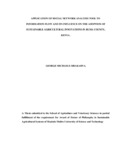APPLICATION OF SOCIAL NETWORK ANALYSIS TOOL TO INFORMATION FLOW AND ITS INFLUENCE ON THE ADOPTION OF SUSTAINABLE AGRICULTURAL INNOVATIONS IN BUSIA COUNTY, KENYA
Abstract
The growth of Agricultural productivity in Western Kenya has lagged behind largely due to low adoption of agricultural innovations. The low adoption is attributed to deficiencies in the existing agricultural extension system. The system for a long time has embraced the linear top-down model of information generation and dissemination. In this model, farmers are regarded as spectators of the innovation development process yet; a lot of information is shared through interpersonal channels within social networks. To help address the issue, Social Network Analysis (SNA) was used to map, measure and analyze social relationships among farmers, agricultural extension service providers and researchers who act as channels for the transfer of information. The study was conducted in 4 villages randomly selected in Nambale Sub-county namely; Elwanikha, Ibanda, Budokomi and Ekisumo. The specific objectives of the study were; to determine flow of agricultural information among the farmers through their social networks, to document relational and structural factors that influence flow of agricultural information within the social networks, to describe the formal and informal communication and their influence on adoption of agricultural innovations and to provide recommendations how extension service providers can make use of social networks to increase the of adoption of agricultural innovations. The study adopted ethnographic research design which comprised of social mapping and in-depth interviews. Initial respondents in each village were purposively identified followed by snowballing to generate subsequent respondents. Data was collected using sociometric technique, semi-structures interviews and in-depth interviews to investigate flow of agricultural information and adoption of three selected agricultural innovations within social networks; 1.) Use of Desmodium (Desmodium uncinatum) to smoother Striga (Striga hermonthica) 2.) Use of lime to control soil acidity 3.) Use of hermetic bags in post-harvest storage of maize. Socio-metric analysis was done using UCINET VI version 6.624. Net draw version 2. 160 an interphase program was used to create illustrative maps. The socio-metric analysis of the villages produced 716 nodes (actors) with 1,952 ties (relationships). The socio-grams showed a mixture of weak and strong and weak ties with a minimum and maximum clustering co-efficient of 0.214 and 0.612 respectively. The study established that the social networks of Nambale Sub-county are characterized by both weak and strong ties which are traits in network structure that are significant in sharing of information on sustainable agricultural innovations. However, agricultural extension workers have failed to take advantage of these existing social networks to disseminate agricultural information because the adoption of the selected innovations was low in all the three villages. By leveraging on the power of social networks, the extension service providers can use the method to map information networks which can be used to disseminate agricultural information that would stimulate adoption of innovations among farmers.

